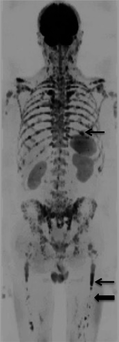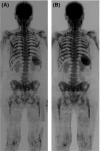Whole body diffusion weighted MRI--a new view of myeloma
- PMID: 26013304
- PMCID: PMC4737237
- DOI: 10.1111/bjh.13509
Whole body diffusion weighted MRI--a new view of myeloma
Abstract
The recent consensus statement from the International Myeloma Working Group has introduced the role of whole body (WB) magnetic resonance imaging (MRI) into the management pathway for patients with multiple myeloma. The speed, coverage and high sensitivity of WB diffusion weighted (DW)-MRI and the unique capability to quantify both burden of disease and response to treatment has led to increasing implementation at leading centres worldwide for imaging malignant marrow disease, both primary and metastatic. WB DW-MRI is likely to have a significant impact on management decisions and pathways for patients with multiple myeloma. This review will introduce the basic principles of DW-MRI, present current evidence for patients with myeloma and will discuss practicalities and exciting future applications.
Keywords: MRI; MRI myeloma; functional studies; imaging; myeloma.
© 2015 The Authors. British Journal of Haematology published by John Wiley & Sons Ltd.
Figures








Similar articles
-
Interobserver agreement of whole-body magnetic resonance imaging is superior to whole-body computed tomography for assessing disease burden in patients with multiple myeloma.Eur Radiol. 2020 Jan;30(1):320-327. doi: 10.1007/s00330-019-06281-x. Epub 2019 Jul 2. Eur Radiol. 2020. PMID: 31267214 Free PMC article.
-
How do we image patients with multiple myeloma and precursor states?Br J Haematol. 2023 Nov;203(4):536-545. doi: 10.1111/bjh.18880. Epub 2023 May 22. Br J Haematol. 2023. PMID: 37217164
-
Role of whole-body MRI for treatment response assessment in multiple myeloma: comparison between clinical response and imaging response.Cancer Imaging. 2020 Jan 30;20(1):14. doi: 10.1186/s40644-020-0293-6. Cancer Imaging. 2020. PMID: 32000858 Free PMC article.
-
Current concepts in tumor imaging with whole-body MRI with diffusion imaging (WB-MRI-DWI) in multiple myeloma and lymphoma.Leuk Lymphoma. 2018 Nov;59(11):2546-2556. doi: 10.1080/10428194.2018.1434881. Epub 2018 Feb 12. Leuk Lymphoma. 2018. PMID: 29431555 Review.
-
Whole-body MRI, dynamic contrast-enhanced MRI, and diffusion-weighted imaging for the staging of multiple myeloma.Skeletal Radiol. 2017 Jun;46(6):733-750. doi: 10.1007/s00256-017-2609-6. Epub 2017 Mar 13. Skeletal Radiol. 2017. PMID: 28289855 Review.
Cited by
-
Imaging of Multiple Myeloma: Present and Future.J Clin Med. 2024 Jan 2;13(1):264. doi: 10.3390/jcm13010264. J Clin Med. 2024. PMID: 38202271 Free PMC article. Review.
-
Alveolar rhabdomyosarcoma confined to the bone marrow with no identifiable primary tumour using FDG-PET/CT.Clin Sarcoma Res. 2015 Nov 19;5:24. doi: 10.1186/s13569-015-0039-6. eCollection 2015. Clin Sarcoma Res. 2015. PMID: 26587222 Free PMC article.
-
Imaging finding of multiple myeloma presenting as soft-tissue disease mimicking extrapleural space tumors: A case report.Acta Radiol Open. 2024 Jun 3;13(6):20584601241246105. doi: 10.1177/20584601241246105. eCollection 2024 Jun. Acta Radiol Open. 2024. PMID: 38835950 Free PMC article.
-
National survey of imaging practice for suspected or confirmed plasma cell malignancies.Br J Radiol. 2018 Dec;91(1092):20180462. doi: 10.1259/bjr.20180462. Epub 2018 Nov 1. Br J Radiol. 2018. PMID: 30102561 Free PMC article.
-
Positron Emission Tomography (PET) Imaging of Multiple Myeloma in a Post-Treatment Setting.Diagnostics (Basel). 2021 Feb 3;11(2):230. doi: 10.3390/diagnostics11020230. Diagnostics (Basel). 2021. PMID: 33546455 Free PMC article. Review.
References
-
- Bartel, T.B. , Haessler, J. , Brown, T. , Shaughnessy, Jr, J.D. , van Rhee, F. , Anaissie, E. , Alpe, T. , Anqtuaco, E. , Walker, R. , Epstein, J. , Crowley, J. & Barlogie, B. (2009) F18‐fluorodeoxyglucose positron emission tomography in the context of other imaging techniques and prognostic factors in multiple myeloma. Blood, 114, 2068–2076. - PMC - PubMed
-
- Bauerle, T. , Hillengass, J. , Fechtner, K. , Zechmann, C.M. , Grenacher, L. , Moehler, T.M. , Christaine, H. , Wagner‐Gund, B. , Neben, K. , Kauczor, H.U. , Goldschmidt, H. & Delorme, S. (2009) Multiple myeloma and monoclonal gammopathy of undetermined significance: importance of whole body versus spinal MR imaging. Radiology, 252, 477–485. - PubMed
-
- Chenevert, T.L. , Stegman, L.D. , Taylor, J.M. , Robertson, P.L. , Greenberg, H.S. , Rehemtulla, A. & Ross, B.D. (2000) Diffusion magnetic resonance imaging: an early surrogate marker of therapeutic efficacy in brain tumors. Journal of the National Cancer Institute, 92, 2029–2036. - PubMed
-
- Dhodapkar, M.V. , Sexton, R. , Waheed, S. , Usmani, S. , Papanikolaou, X. , Nair, B. , Petty, N. , Shaughnessy, Jr, J.D. , Hoering, A. , Crowley, J. , Orlowski, R.Z. & Barlogie, B. (2015) Clinical, genomic, and imaging predictors of myeloma progression from asymptomatic monoclonal gammopathies (SWOG S0120). Blood, 123, 78–85. - PMC - PubMed
Publication types
MeSH terms
Grants and funding
LinkOut - more resources
Full Text Sources
Other Literature Sources
Medical

